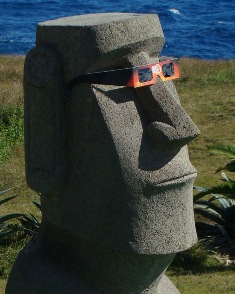
| Main Page |
Eclipse Page |
 |
Easter Island 2010 Eclipse Page |
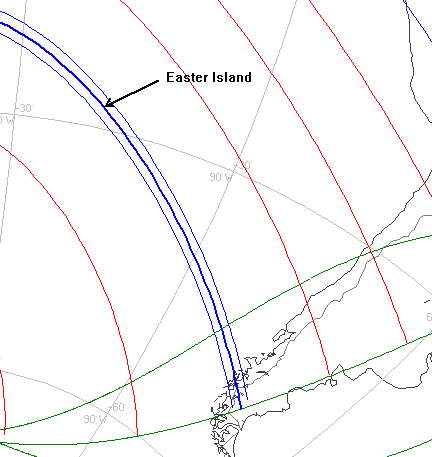 |
Eclipses have taken me to the ends of the earth. Novosibirsk, Siberia, Russia and Zambia were hardly on my bucket list; however, Easter Island is someplace I have always wanted to go. The
natives bill Rapa Nui as “the most remote
place on earth”. I supposed if the claim is based on the distance from
others
then it is safe as the nearest occupied land is Pitcairn Island.
However, a
place with regular ship and plane service as well as cell phone and
internet is
not “off the grid”. That distinction more correctly belongs to its
neighbor. You
can
reach the island from either Tahiti or Santiago. For
our
group it was a 5
hour flight from Chile. It’s winter there now. Santiago was surrounded
by snow
covered hills. Easter Island is in its rainy season - not ideal eclipse
weather. . |
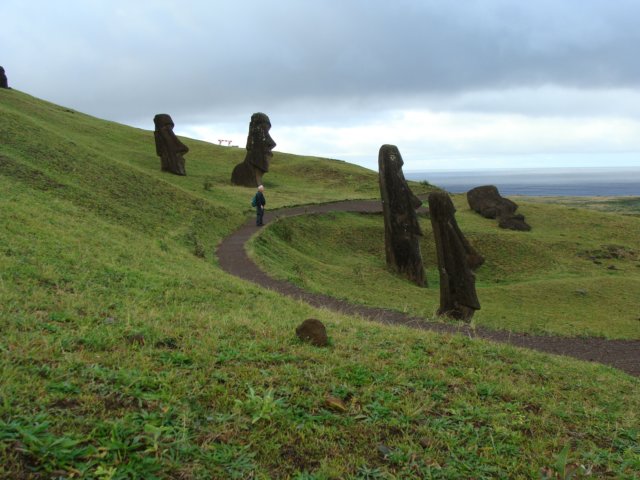 |
Easter
Island is
famous for its moai which are the remnants of the native civilization.
Almost
all of the people now live in the southwest corner. Most of the
island is a World Heritage Park
which preserves a pastoral feel for the island as opposed to the
suburban
sprawl of Tahiti. All of the moai were toppled before first European
contact
due to internal fighting. The various
sites in the park contain the moai in various states of well restored,
badly restored,
and left alone. For more pictures of Easter Island see the Easter Island Picture Page |
The morning of the eclipse looked hopeful. The weather was broken to scattered clouds, but with very high winds. As the morning progressed clumps of clouds raced past. It was anyone’s guess whether totality would be in a cloud or a clear patch.
This was going to be a 4 minute plus eclipse so I thought it would not have as interesting a shadow as in Russia. In the similarly long Libya eclipse I used a computer to execute a carefully scripted program. This snapped shots of the prominences at the start slowing down to take a shot of the new moon in earthshine. In Libya the computer allowed me to observe with minimal interruptions. Since I wanted to actually look at the eclipse this time as well (as opposed to futzing with a camera) I decided on a simple plan, but one that would allow me to capture something that I have never seen before: Baily’s Beads.
Baily’s Beads
occur in the seconds before 2nd
contact and after 3rd contact (when the photosphere
disappears and
reappears). The moon is not a perfect sphere. The sun shining through
valleys
along the edge results in a beaded appearance, but only for a second or
so. Since
the bright surface of the sun is still visible you have to view these
with a
telescope using either a solar filter or with a camera using very fast
shutter
speed. Using a solar filter would not
work since I wanted to see/capture the prominences that are visible for
the few
seconds after (before) contact. I did not
want to be fussing with a solar filter while totality was happening!
Thus I
wanted to try with a camera on my telescope set to a fast speed
(1/1250) controlled
by a shutter release with me madly pushing the camera to get as many
photos as
possible.
The warning on
every telescope I have ever seen is to not
point it at the sun. That is good advice and our safety briefing
included many
examples of the sun causing damage to optics. I have personally seen a
magnifying finder burn a hole in the reticle when someone forgot to
cover it when observing a
sunset comet a few years ago. Thus taking these
pictures without
damaging my equipment was part of the challenge.
The technique I used was to stand in front of my scope about a minute before totality. I removed the solar filter and replaced it with a black plastic bag. I then sat down and watched the sun through solar glasses. As I could see totality approaching I removed the plastic bag. I later measured that it was about 51 seconds before 2nd contact which was earlier than I wanted to, but still OK. It was unsafe to look through the viewfinder so I snapped picture using the shutter cable hoping I was getting something. As we got closer to totality I snapped faster.
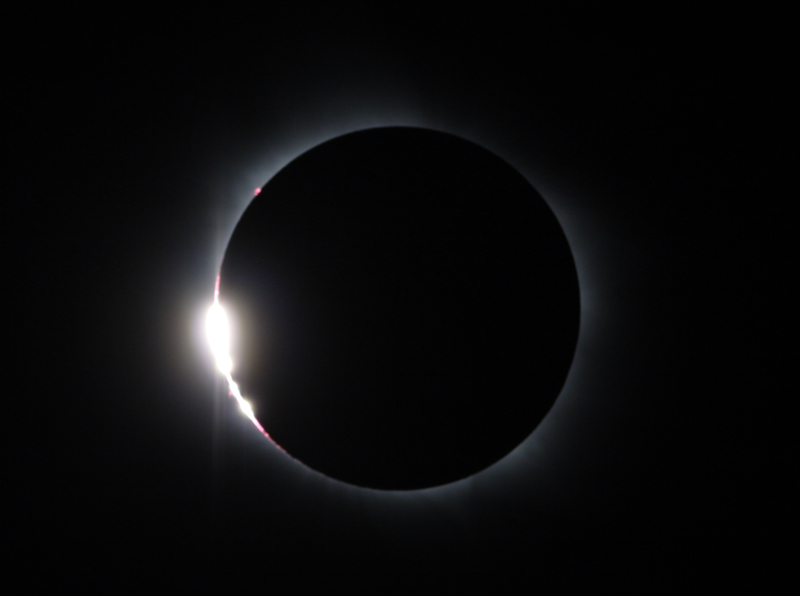
The best
picture was about 7 seconds before 2nd
contact. It clearly shows the beads. At this point the sun was still
too bright
to observe unaided. I caught the sequence before and right after 2nd
contact as well as some inner corona. I looked up once my 2nd
contact and corona pictures were finished and was mesmerized. It was
the most
beautiful and detailed corona I have ever seen. I almost forgot that
inches
from my head was a 1000mm equivalent lens. After a minute or so I
switched to
my eyepiece. I studied the detailed
magnetic lines in the corona. At that
magnification I could not see the outer corona, but it was my best view
ever of
the inner. Eventually I started seeing
the prominences emerge on the other side. When I saw the red
chromosphere I
moved my eyes from the eyepiece and shot my 3rd contact set.
In 2016 I went back and reconverted some of the images from this project. Among them was this shot of the prominences which I then enhanced using PixInsight
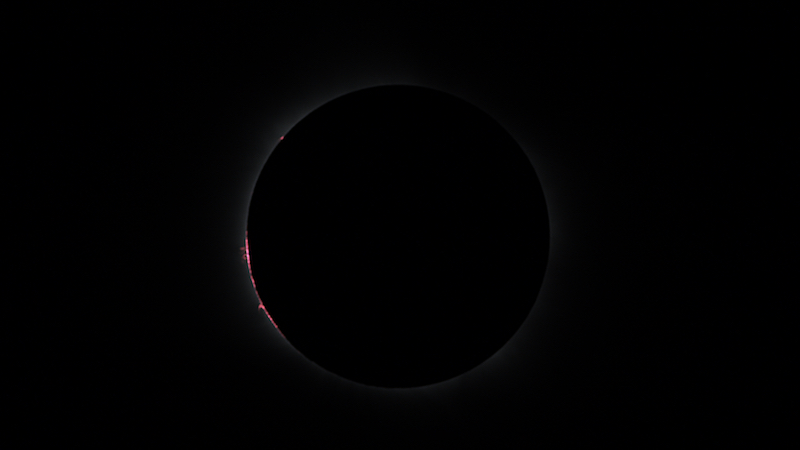
See all of the
pictures and the 2nd contact movie on the
2010 Eclipse
Picture Page.
One important
last point. It does not make sense to go to an
eclipse and not look at it. I thought I had only been messing with the
camera
for a couple of seconds after 2nd contact. Looking at the
shot
timings it was actually 43 precious seconds! That did give me another
3+ minutes
to actually look, but many eclipses are shorter.
Eclipses are
addicting. A community of people regularly
travel to them. .
The
next
two
are
on
a
boat
and
short
(2012
and 2013)
so
I
will
leave
the
fancy
equipment
at
home.
Also in 2012
an annular
eclipse
comes to northern California. In 2017
totality
comes to the states!
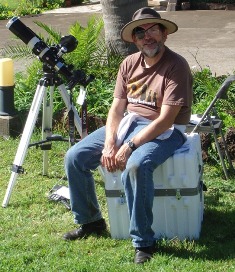 |
The
sun is
really small in the sky. If you just take an image with the normal lens
of a camera you will just get a dot. From
experience I knew that I wanted 700-800mm. That meant using a
telescope and tracking. Fortunately I had experience with this in
the 2006 Libya trip. My telescope is a TeleVue 76. This is a relatively small APO and it mates well with DSLR. The combination yielded an effective focal length of 768 mm at f/ 6.3. It is relatively light and fits in a wheeled carry on (with a lot of padding). I was able to consistently get in the overhead bin to protect it (but it survived a trip in the hold of a commuter plane in 2006). My camera is a Canon 20Da. This was a variant of the 20D issued by Canon for astrophotography. It's main feature was a different IR filter that did not attenuate H-Alpha as strongly. That is useful for pictures of the sun since most of the red is H-Alpha. |
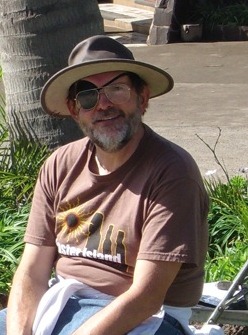 |
Eclipses
are short and the
surroundings transition from near daylight
brightness to the equivalent of full moon illumination in the matter of
a second. Since it takes about 1/2 hour to get dark adapted there
is no way that the human eye can prepare itself to see the subtle
features of the corona. In 2006 I experimented with an eye patch while watching the eclipse in Libya. I put a patch on my eye at least 1/2 hour before 2nd contact. I did it again in 2008 during the Russia eclipse. There it allowed me to see more detail than I had seen before. I tried it again in China, but I had bigger problems then. I gave it another go this year. That may be the reason that I thought the corona was as detailed as it was. |
